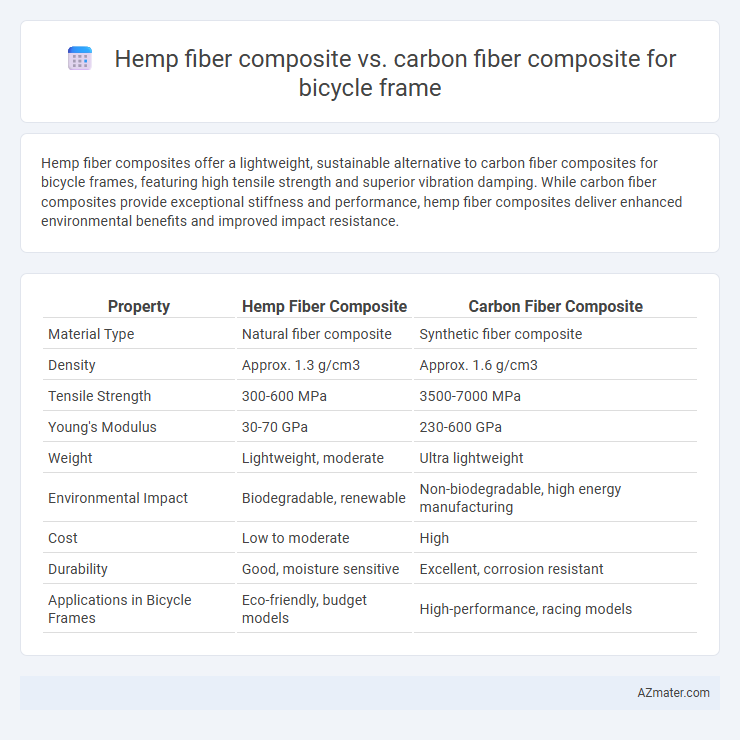Hemp fiber composites offer a lightweight, sustainable alternative to carbon fiber composites for bicycle frames, featuring high tensile strength and superior vibration damping. While carbon fiber composites provide exceptional stiffness and performance, hemp fiber composites deliver enhanced environmental benefits and improved impact resistance.
Table of Comparison
| Property | Hemp Fiber Composite | Carbon Fiber Composite |
|---|---|---|
| Material Type | Natural fiber composite | Synthetic fiber composite |
| Density | Approx. 1.3 g/cm3 | Approx. 1.6 g/cm3 |
| Tensile Strength | 300-600 MPa | 3500-7000 MPa |
| Young's Modulus | 30-70 GPa | 230-600 GPa |
| Weight | Lightweight, moderate | Ultra lightweight |
| Environmental Impact | Biodegradable, renewable | Non-biodegradable, high energy manufacturing |
| Cost | Low to moderate | High |
| Durability | Good, moisture sensitive | Excellent, corrosion resistant |
| Applications in Bicycle Frames | Eco-friendly, budget models | High-performance, racing models |
Introduction to Bicycle Frame Materials
Hemp fiber composites offer a sustainable and lightweight alternative to traditional materials in bicycle frame construction, combining natural fibers with resin to create strong, vibration-damping structures. Carbon fiber composites remain the preferred choice for high-performance frames due to their exceptional strength-to-weight ratio and stiffness, enabling superior responsiveness and aerodynamics. The selection between hemp fiber and carbon fiber composites depends on balancing environmental impact, cost, and performance requirements specific to cycling disciplines.
Overview of Hemp Fiber Composites
Hemp fiber composites consist of natural hemp fibers embedded in a polymer matrix, offering an eco-friendly alternative to traditional materials. These composites provide high tensile strength, good vibration damping, and reduced weight, making them suitable for sustainable bicycle frames. Hemp fibers absorb less energy during impacts, enhancing durability while minimizing environmental impact compared to carbon fiber composites.
Overview of Carbon Fiber Composites
Carbon fiber composites consist of carbon fibers embedded in a polymer matrix, offering exceptional strength-to-weight ratios and stiffness critical for high-performance bicycle frames. These composites provide superior fatigue resistance and vibration damping, contributing to enhanced ride quality and durability. The advanced manufacturing processes and high material costs position carbon fiber frames as premium options in the cycling industry.
Mechanical Properties: Strength and Stiffness Comparison
Hemp fiber composites offer moderate tensile strength and stiffness, typically ranging from 30 to 60 MPa and 3 to 7 GPa respectively, making them lightweight and eco-friendly alternatives for bicycle frames. Carbon fiber composites exhibit superior mechanical properties, with tensile strength often exceeding 500 MPa and stiffness above 70 GPa, providing exceptional rigidity and durability for high-performance cycling. While hemp fiber composites provide sustainable benefits and impact resistance, carbon fiber composites dominate in strength-to-weight ratio and stiffness, crucial for competitive and high-speed bicycle applications.
Weight Analysis: Hemp vs Carbon Fiber
Hemp fiber composites exhibit a higher density and lower tensile strength compared to carbon fiber composites, resulting in a relatively heavier bicycle frame when using hemp. Carbon fiber composite frames typically weigh around 1 to 1.5 kilograms, whereas hemp fiber-based frames often exceed this range by 20-30%, impacting overall bike weight and performance. Weight analysis highlights carbon fiber's superiority in achieving lightweight and high-strength frames ideal for competitive cycling applications.
Environmental Impact and Sustainability
Hemp fiber composites offer a significantly lower environmental impact compared to carbon fiber composites due to their renewable sourcing, lower energy consumption during production, and biodegradability. Carbon fiber composites, while stronger and lighter, involve energy-intensive manufacturing processes and generate non-recyclable waste, contributing to higher carbon emissions and environmental burden. Hemp fiber strengthens bicycle frames sustainably by reducing reliance on fossil fuel-based materials and enabling end-of-life composting, making it an eco-friendly alternative for green transportation solutions.
Manufacturing Process and Cost Efficiency
Hemp fiber composites in bicycle frames leverage low-energy processing techniques such as resin infusion and compression molding, resulting in reduced manufacturing costs compared to carbon fiber composites that require high-temperature curing and autoclave processing. The use of natural hemp fibers decreases material expenses and shortens production cycles, enhancing cost efficiency while maintaining adequate strength and flexibility. Carbon fiber composites demand significant investment in specialized equipment and labor-intensive processes, increasing overall frame costs despite superior weight-to-strength ratios.
Ride Quality and Vibration Damping
Hemp fiber composites offer superior vibration damping and a smoother ride quality compared to carbon fiber composites due to their natural fiber structure that absorbs road vibrations more effectively. Carbon fiber composites deliver higher stiffness and lighter weight, enhancing responsiveness but transferring more road vibrations to the rider. Riders seeking comfort and reduced fatigue often prefer hemp fiber frames, while performance-focused cyclists prioritize carbon fiber for its rigidity and efficiency.
Durability and Maintenance Considerations
Hemp fiber composites offer excellent vibration damping and moderate durability, making them a sustainable option for bicycle frames with less environmental impact compared to carbon fiber composites. Carbon fiber composites provide superior strength-to-weight ratios and exceptional durability but require careful maintenance to prevent damage from impacts and UV exposure. Hemp fiber frames generally demand less specialized care, while carbon fiber frames benefit from regular inspections and professional repairs to maintain performance.
Future Trends in Bicycle Frame Composites
Hemp fiber composites are gaining traction for bicycle frames due to their sustainability, lightweight properties, and vibration damping capabilities, positioning them as eco-friendly alternatives to carbon fiber composites. Carbon fiber composites continue to dominate with superior strength-to-weight ratios and stiffness, but future trends indicate increasing integration of bio-based resins and hybrid composites combining hemp and carbon fibers to enhance performance and reduce environmental impact. Advancements in manufacturing technologies such as automated fiber placement and 3D printing are expected to accelerate the adoption of these innovative materials in high-performance bicycle frames.

Infographic: Hemp fiber composite vs Carbon fiber composite for Bicycle frame
 azmater.com
azmater.com